#Peter Boretski
Explore tagged Tumblr posts
Text









n a k e d l u n c h, 1991 🎬 dir. david cronenberg
'I misplaced the gear in a manner of speaking.' - lee
'We saw you go off with the heat, in fact. They won't give it back to Cohen. It's evidence, they say. Is that why you tried to lift mine?' - edward
'That's unkind, Edward. "Lift" is unkind.' - lee
#film#naked lunch#naked lunch 1991#david cronenberg#peter weller#judy davis#roy scheider#Michael Zelniker#Peter Boretski#William Lee#Joan Lee#Dr. Benway#Martin#Bug Powder Problems/ William Tell Routine
5 notes
·
View notes
Photo
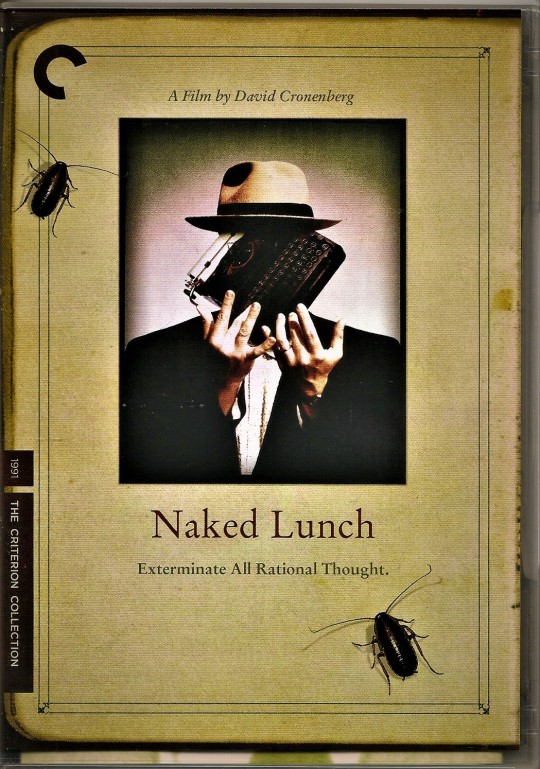
Bad movie I have Naked Lunch 1991
#Naked Lunch#Recorded Picture Company#Peter Weller#Judy Davis#Ian Holm#Julian Sands#Roy Scheider#Monique Mercure#Nicholas Campbell#Michael Zelniker#Robert A. Silverman#Joseph Scoren#Peter Boretski#Yuval Daniel#John Friesen#Sean McCann#Howard Jerome#Michael Caruana#Kurt Reis#Louis Ferreira#Julian Richings#Jim Yip#Claude Aflalo#Laurent Hazout#Joseph Di Mambro
5 notes
·
View notes
Photo

#the nutcracker prince#kiefer sutherland#megan follows#mike macdonald#peter boretski#phyllis diller#peter o'toole#noam zylberman#paul schibli#1990
34 notes
·
View notes
Quote
They had a sign on the gates of Auschwitz. Arbeit macht frei. 'Work will set you free.' The cruelest lie ever told. There's only one thing that can set you free Aaron. It's the truth."
Leon Zgierski in The Outer Limits (1995-2002) "The Tribunal" (1999) written by Sam Egan
#sam egan#aaron zgierski#leon zgierski#saul rubinek#peter boretski#arbeit macht frei#the outer limits#the tribunal#veritas vos liberabit#Why is this old Jewish man quoting Jesus? I don't know.#ten-year old thought this was deep though
3 notes
·
View notes
Photo


Films Watched in 2020:
19. Naked Lunch (1991) - Dir. David Cronenberg
#Naked Lunch#David Cronenberg#Peter Weller#Judy Davis#Ian Holm#Roy Scheider#Julian Sands#Nicholas Campbel#Peter Boretski#Monique Mercurie#Joseph Scoren#William S. Burroughs#Films Watched in 2020#My Edits#My Post
3 notes
·
View notes
Photo

#naked lunch#Exterminator 2#peter boretski#stealing#subway#bug sprayer#david cronenberg#peter suschitzky
1 note
·
View note
Photo

I understood writing could be dangerous. I didn't realize the danger came from the machinery.
Naked Lunch, David Cronenberg (1991)
#David Cronenberg#Peter Weller#Judy Davis#Ian Holm#Julian Sands#Roy Scheider#Monique Mercure#Nicholas Campbell#Michael Zelniker#Robert A. Silverman#Joseph Scoren#Peter Boretski#Yuval Daniel#John Friesen#Peter Suschitzky#Ornette Coleman#Howard Shore#Ronald Sanders#1991
5 notes
·
View notes
Photo




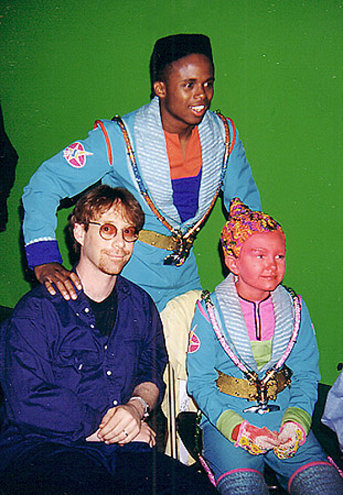





Space Cases
#Space Cases#Jewel Staite#Walter Jones#Bill Mumy#Kristian Ayre#Rahi Azizi#Paige Christina#Anik Matern#Cary Lawrence#Paul Boretski#Peter David#Nickelodeon#90s
150 notes
·
View notes
Text
Top-4 Badass Female Rulers
Strong women in power more than once sparkled like bright stars on the canvas of history. Let's take a look at some of them that have left their mark on the history of Russia. 1. Princess Olga Our first officially known female ruler and the first Orthodox ruler. She’s a princess who ruled Kievan Rus from 945 to 960 as regent under her young son Svyatoslav, after the death of her husband, Prince Igor. She was known as a proud, wise and brave woman. She signed several lucrative contracts with neighboring lands, laid the foundation for stone urban planning, streamlined tax collection and paid attention to the improvement of the lands under her control. There is a legend about how Olga outwitted the Byzantine king. He, marveling at her intelligence and beauty, wanted to marry Olga, but the princess rejected his claims, noting that it was not proper for Christians to marry pagans. It was then that the king and the patriarch baptized her. When the king again began to harass the princess, she pointed out that she was now his goddaughter, so he couldn’t marry her anyway.

But her cruel revenge for the death of her beloved husband is best known. In 945, Prince Igor died at the hands of the Slavic tribe of the Drevlyans after repeatedly collecting tribute from them. After the murder of Igor, the Drevlyans sent 20 "best husbands" to Olga, deciding to woo her to their prince Mal. Olga pretended to agree to the Drevlyans' proposal, and, allegedly in order to honor the ambassadors, ordered her subjects to solemnly carry them on boats to her palace. Meanwhile, a pit had already been dug in the courtyard, into which, by order of Olga, the ambassadors were thrown. In 946, Olga went out with an army on a campaign against the Drevlyans. According to Russian chronicles, after an unsuccessful siege during the summer, Olga burned the city of the Drevlyans, Iskorosten, with the help of birds, to whose feet she ordered to tie lighted tows with sulfur. Some of Iskorosten's defenders were killed, the rest obeyed. After the reprisal against the Drevlyans, Olga began to rule Russia until Svyatoslav came of age, but even after that she remained the de facto ruler, since her son spent most of his time on military campaigns and didn’t pay attention to managing the state.
2. Marfa Boretskaya, also known as Martha the Mayoress Formally, Martha was never a ruler, but she had great influence as the widow of the Novgorod mayor Isaac Boretsky, and she was one of the leaders of the Novgorod opposition to Ivan III. In the Novgorod folk legends, Martha appears in the form of a strong and domineering ruler who firmly held her position no matter what. In the 15th century, autocracy spread across Russia, but the Novgorod principality remained a stronghold of democracy. Martha and her son, the Novgorod dignified mayor Dmitry, in 1471 advocated the withdrawal of Novgorod from dependence on Moscow. Martha was the informal leader of the boyar opposition to Moscow; she was supported by two more noble Novgorod widows. Martha, who possessed significant funds, negotiated with the Grand Duke of Lithuania and King of Poland Casimir IV on the entry of Novgorod into the Grand Duchy of Lithuania on the basis of autonomy while preserving the political rights of Novgorod.
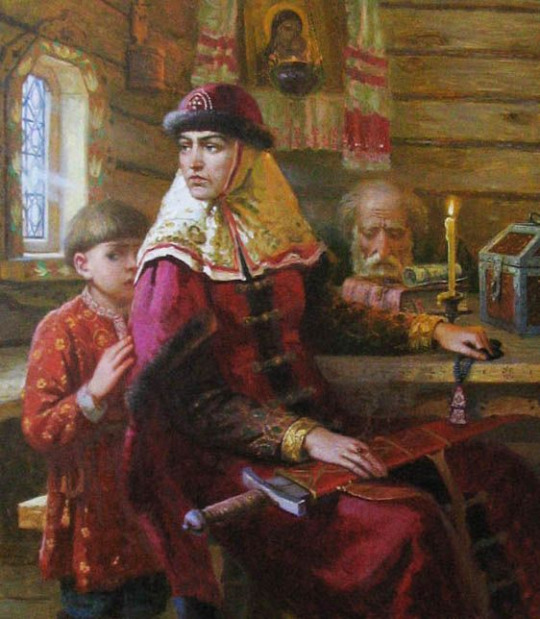
Upon learning of the negotiations on the annexation of Novgorod to the Grand Duchy of Lithuania, Grand Duke Ivan III declared war on the Novgorod Republic and defeated the army of Novgorod in the Battle of Shelonsk (1471). Martha’s son was executed as a political criminal. However, Novgorod's right to self-government in its internal affairs was retained. Martha, despite the death of her son and the actions of Ivan III, continued negotiations with Casimir, who promised her support. In 1478, during a new military campaign, Ivan III finally deprived the Novgorod lands of the privileges of self-government, extending the power of autocracy to them. The veche bell, which used to call the townspeople to meetings, as a symbol of Novgorod democracy, was taken to Moscow. Martha's lands were confiscated, she and her grandson Vasily were first brought to Moscow, and then sent to Nizhny Novgorod, where she was tonsured a nun under the name of Mary in the Conception (since 1814 - Holy Cross) monastery, where she died in 1503. 3. Princess Sophia Alekseevna Romanova Another strong woman with a tragic fate. Voltaire said about her: “She had a lot of intelligence, she wrote poetry, was a skilled writer and orator, she combined a pleasant appearance with lots of talents; they were overshadowed only by her ambition". She ruled as regent of Russia from 1682 to 1689, during the minority of her brother Ivan V and half-brother Peter I. A daughter of tsar Alexei Mikhailovich Romanov and Maria Miloslavskaya, she lost her father during a period of violent feuds that broke out between relatives of her deceased mother and stepmother. According to the laws of that time, only a man could inherit the throne. Sophia had no rights to it, although she was an older sister. After the Streltsy revolt, in May 1682, the warring factions reached a compromise and chose two tsars, two half-brothers - Ivan V and Peter I. Sophia headed the government under both minor tsars.
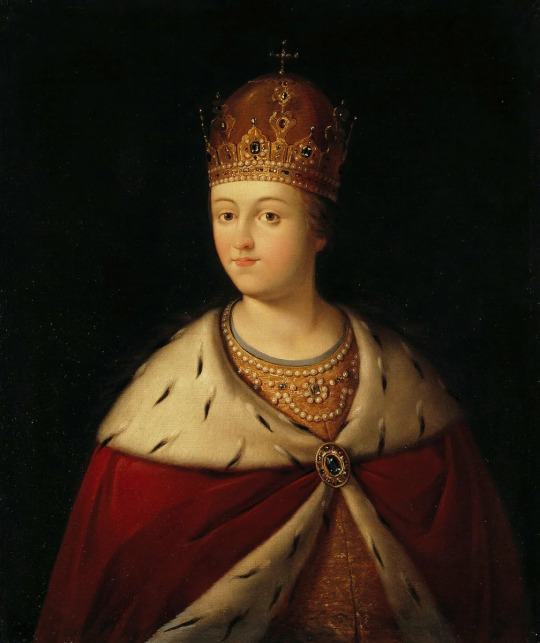
Sophia achieved that her name was included in the official royal title "Great Sovereign and Grand Princess and Grand Duchess Sophia Alekseevna". A few years later, her image was minted on coins, and from 1686 she already called herself an autocrat and the next year she issued this title by a special decree. The policy of the reign of Princess Sophia in many ways contributed to the renewal of public life. Industry and trade began to develop noticeably. The country began to produce velvet and satin. The Slavic-Greek-Latin Academy was opened. International contacts are being established. Sophia began to reorganize the army according to the European model. Even the noble supporter of Peter I, Prince Kurakin, admitted: Sophia ruled “with all diligence and justice, so there was never such a wise government in the Russian state. And in the whole state during her reign great wealth flourished, commerce, and crafts, and science also multiplied... and the freedom of the people triumphed". But time passed, Prince Ivan died and Prince Peter grew up. Like Sophia, he actively advocated reforms for the good of the state, but Sophia flatly refused to cede the throne to her half-brother.

Sophia lost power while trying to eliminate Peter, who had already reached adulthood. In 1689, relations between Sophia and the boyar-noble group that supported Peter I escalated to the extreme. As a result, the party of Peter I won the final victory, and the royal biography of Sophia ended. All supporters of the princess lost their real power, her name was excluded from the royal title. Sophia herself was sent without tonsure to the Novodevichy nunnery in Moscow, where she copied church books and wrote a lot. During the Streltsy Uprising of 1698, Sophia repeated her attempt to gain power. In her letters to the streltsy, she asked to support her and oppose Peter I. The uprising was brutally suppressed. Sophia was tonsured as a nun and imprisoned in the nunnery forever.

The tragic story of his half-sister prompted Peter I to issue a decree on succession to the throne in 1722. The decree canceled the ancient custom of transferring the royal throne to direct descendants in the male line and provided for the appointment of an heir to the throne at the behest of the monarch. 4. Catherine II or Catherine The Great The 18th century in the Russian Empire was the heyday of the Russian "kingdom of women" - and the most beautiful flower in this garden was Empress Catherine the Great. The country's longest-ruling female leader (1762 – 1796). She came to power following a coup d'état that overthrew her husband, Peter III. Under her reign, Russia was revitalised; it grew larger and stronger, and was recognised as one of the great powers of Europe.
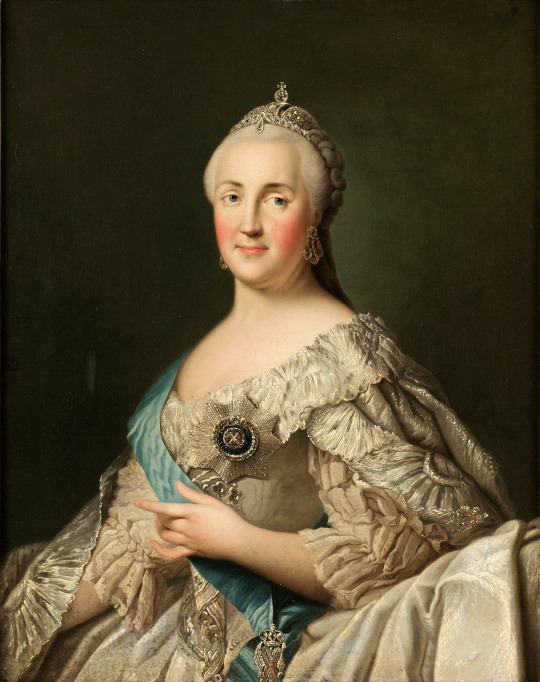
She wasn’t Russian in blood, but she became one in spirit. Sophia Frederica Augusta of Anhalt-Zerbst converted to Orthodoxy and received the name Catherine, studied Russian language and Russian culture. The Empress formulated the tasks facing the Russian monarch as follows: - to educate the nation to be governed; - to introduce good order in the state, to support society and make it comply with the laws; - to establish a good and accurate police force in the state; - contribute to the flourishing of the state and make it abundant; - to make the state formidable in itself and inspiring respect for its neighbors. Under Catherine, special attention was paid to the development of women's education, in 1764 the Smolny Institute for Noble Maidens and the Educational Society for Noble Maidens were opened. The Academy of Sciences has become one of the leading scientific bases in Europe. In the provinces there were orders of public charity. In Moscow and St. Petersburg there are orphanages for homeless children, where they received education and upbringing. The Widows Treasury was created to help widows. If we talk about the disadvantages of her rule, then they include favoritism, corruption and connivance with the nobility to the detriment of ordinary people and especially serfs.The ideas expressed by Diderot and Voltaire, of which she was an adherent in words, didn’t correspond to her internal politics. They defended the idea that every person is born free, and advocated the equality of all people and the elimination of medieval forms of exploitation and despotic forms of government. Contrary to these ideas, under Catherine there was a further deterioration in the situation of serfs, their exploitation intensified, inequality grew due to the granting of even greater privileges to the nobility. In general, historians characterize her policy as "pro-noble" and believe that despite the empress's frequent statements about her "vigilant concern for the welfare of all subjects", the concept of the common good in the era of Catherine was the same fiction as in general in Russia in the 18th century.
2 notes
·
View notes
Text
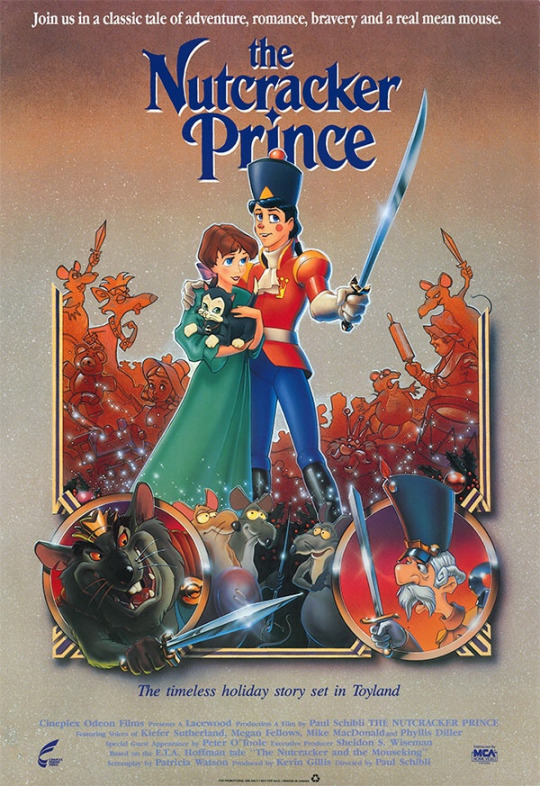
Merry Christmas everyone! To conclude this month of merrymaking we’re looking at an animated Christmas cult classic that I have a bit of a soft spot for. But perhaps it’s best to start at the beginning:
ETA Hoffman’s “The Nutcracker and the Mouse King” is one of my favorite fantasy stories, though chances are you’re more familiar with the famous ballet by Tchaikovsky that it inspired. The music is gorgeous and instantly recognizable, but few know the actual story of The Nutcracker beyond what your average community production rolls out every December. Much of the plot plays out like a variation of Beauty and the Beast with a protagonist akin to The Wizard of Oz’s Dorothy and story elements that wouldn’t feel out of place in a Grimms’ fairytale. Sadly, most of those details were lost in the translation from book to light holiday entertainment. Not that I’m complaining, I love the ballet, but there’s so much more to its origins that people aren’t usually interested in delving into.
I say all this because today’s movie, The Nutcracker Prince, is one of the very few filmic adaptations that pays faithful tribute to both its source material and its theatrical counterpart. In spite of – or perhaps because of – the popularity of the ballet, there’s been only a handful of film versions of Hoffman’s The Nutcracker (or at least a handful compared to something like A Christmas Carol). How good you find each of them to be depends upon your taste and the production value. I’ve found remarkably little about the making of this particular adaption, but that probably has to do with the fact that it was barely a blip on the box office radar. Released through Warner Brothers (which itself would issue another Nutcracker movie starring Maculay Culkin six years later), this was the only full-length animated feature created by Canada’s Lacewood Productions. A shame, really, because looking at The Nutcracker Prince you can see the studio’s potential. But thanks to the home video circuit, the movie has found a new life as a nostalgic Christmas classic for 90’s kids like myself. Let’s unwrap the reasons why, shall we?
If there’s one thing I appreciate about The Nutcracker Prince, it’s how it plays around with the music order to emphasize a scene’s mood rather than slavishly follow the original score. Instead of the recognizable jovial overture piping over the main titles, we have the Snowflake Waltz from the finale of Act 1, building an aura of mystery and magic to lure us into the story. A series of cross-hatched stills introduce us to our cast and characters, and I tell you, when you recognize these names you will not be able to look at this movie the same way. If I told someone that Anne of Green Gables, Jack Bauer, Lawrence of Arabia, Jimmy Neutron’s grandma and several prominent cast members from Canada’s Saturday morning fixture The Raccoons shared the screen together once, they’d think I was crazy, but as you’ll see it’s the honest to Zeus truth.
Our story begins proper with Clara Stahlbaum (Meagan Follows) and her younger brother Fritz delivering last-minute gifts to their neighbors on Christmas Eve. They race through the icy streets of Germany until they reach the shop of eccentric family friend Uncle Drosselmeier (Peter Boretski), a clockmaker and expert craftsman of mechanical toys. Drosselmeier greets the children and they invite him to come light up the Christmas tree with the family, but he enigmatically tells them he has to prepare for his nephew. This comes as news to Clara and Fritz, since they’ve known Drosselmeier for their whole lives and have never heard him mention a nephew before. Drosselmeier sends them on their way promising he’ll be at the Stahlbaum’s party that evening. Once they’re gone, he hints that there may be something magical in the air this Christmas…

“Blasted pixie dust everywhere! Once the holidays are done I’ve got to get the place fumigated!”
On their way home Clara and Fritz debate what Uncle Drosselmeier’s big annual present he makes for the family will be this time. Fritz, the little future warlord that he is, wishes for a working fort with a mechanical army, while Clara dreams of an enchanted garden where swans in golden necklaces glide across the water. This conversation is a little holdover from the Hoffman story that I like. One of the most difficult challenges every writer faces is writing natural sounding dialogue for children; while Hoffman’s dialogue is a bit stilted by the conventions of the era, the meaning still comes through. Fritz laughs at Clara’s fantasy but because he finds the idea of swans wearing jewelry more ludicrous than a magic garden, which is how an ebullient boy like him would think.
Back at the Stahlbaums, preparations for the Christmas party are underway. The parents give their children their presents: older sister Louise (who’s often excised from other adaptations) receives a pretty new dress, Fritz a hobby horse and toy soldier gear, and Clara a pair of ballet slippers and a new doll she christens Marie. I have to wonder if this is some kind weird in-joke since in the story, the main character is called Marie and the doll she receives is the one who’s named Clara. What happened during the process of making this movie that resulted in their names being switched? Clara is thrilled since these slippers bring her one step closer to her dreams of joining the royal ballet, but feels a touch bemused when she overhears her mother getting choked up at the notion that this may be Clara’s last doll.
The party arrives, including Louise’s boyfriend Eric. Clara and Fritz tease the lovebirds (though to be frank, anyone who wears a powdered wig twelve years out of fashion to something that isn’t a costume party deserves to be ridiculed) but something about their shared intimacy stirs something within Clara. This on top of the adult party guests commenting on how fast she is growing marks her entrance into that state of melancholy and confusion that comes from standing between childhood and adulthood and not knowing where you belong. Clara’s age is never mentioned though I suspect she’s roughly twelve or thirteen, right on the cusp of adolescence and about the time where that mindset begins to sink in. She still plays with dolls and treats them like they were alive, but imagines a future as an adult. There’s a growing sadness over the impending decision between the two that she subconsciously acknowledges through her playing with Marie. This theme isn’t present in the Hoffman story (Marie is a confirmed seven year old in the prime of juvenescence) but it’s been incorporated into the Maurice Sendak retelling a couple of years prior to The Nutcracker Prince and I like its inclusion here as well.
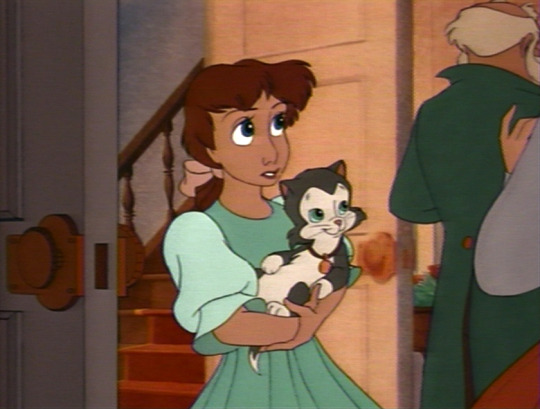
“I wonder if this is anything like what my pen pal Wendy went through with that Peter boy…nah, you’re overthinking it, Clara.”
But there’s no time for her to ponder the implications as a crack of thunder, gust of wind and explosion of fireworks marks the arrival of the final party guest – Drosselmeier. He comes bearing his greatest creation, an enchanting music box castle complete with marching soldiers, seven swans a-swimming, and figures dancing inside the ballroom. In another humorous scene from the original story, Clara and Fritz fawn over the castle while frustrating Drosselmeier with their requests to make the automated figures do more, leading him to go on a brief “kids today don’t appreciate shit” rant.
As the party guests waltz to the strains of more Tchaikovsky, Clara wanders by the tree and spies a present she hadn’t noticed before – a nutcracker in the shape of a soldier. He’s not the most handsome toy in the box, but there’s something charming about him that she is drawn to. Drosselmeier confesses that he’s just part of his gift for the family and demonstrates how he works. On seeing the Nutcracker, Fritz wrestles him out of Clara’s arms and insists he has a go. But because there are no nuts left, he tries one of his toy cannonballs and breaks its jaw. Drosselmeier cheers Clara up by telling a story of how the Nutcracker came to look as he does. And this is where things get…weird.
Now I don’t mind the inclusion of the story-within-a-story. I’m happy they go into how the Nutcracker was cursed unlike most other versions, and there’s some good gags thrown in that make me chuckle. It’s how they go about it that I take some issue with. First, look at the movie’s style looked so far.
The character designs are clearly inspired by Disney – big eyes, soft rounder faces, realistic body proportions for the main characters, only slightly exaggerated for the lesser ones. The backgrounds are warmly lit and richly detailed, like an early work by Thomas Kincade. Overall it feels like something out of a classic storybook.
Now here’s some screencaps from Drosselmeier’s story.
“All right, who changed the channel to Cartoon Network?”
The scene doesn’t even look like it’s from the same movie. It goes from feature film quality to a Saturday morning cartoon, and that’s not entirely coincidental. Lacewood Productions grew out of Hinton Animation Studios which primarily made, you guessed it, cartoons for tv. And Hinton Animation itself had its roots in Atkinson Film-Arts, the studio that produced The Raccoons, hence why some of the cast makes appearances. But because I couldn’t find anything on the making of The Nutcracker Prince, we’ll never know if they went this route because the budget ran out, or the animators didn’t feel comfortable drawing the entire movie in the Disney house style and worked out some kind of compromise, or they just wanted the reveal of the Nutcracker’s human form at the end to be an even bigger surprise. Given some time and creativity they might have been able to come up with something better. You could argue this is how Clara envisions the story playing out in her head, but I don’t think a child from the 1800’s would imagine a fairy tale in the style of Danny Antonucci. In fact, if you played music from Ed Edd and Eddy over this part it wouldn’t feel out of place. Everything is played up for nothing but laughs, not even the Nutcracker’s transformation into a lifeless object, which should be an emotional gut punch. And I’d be ok with all this if it was a short sequence, but it lasts fifteen minutes. That might not seem like long, but since this movie is only seventy-five minutes that means it takes up a good portion of its first half. Plus the cuts back and forth between the story to it being told reminds you of how jarring the whole sequence is compared to the rest of the film.
But on to the story itself. Drosselmeier’s tale takes place in a faraway kingdom belonging to a King who I can only describe Yosemite Sam in his golden years right down to the ornery western accent (it wasn’t until doing my research that I discovered he’s voiced by the Texan monster from the Beetlejuice cartoon which certainly explains it), an extreme doormat Queen, and their daughter, the “beautiful” but very spoiled and unfortunately named Princess Pirlipat. They have in their employ a world-famous clock maker and magician coincidentally also named Drosselmeier and his apprentice, his shy nephew Hans (Kiefer Sutherland).
“Patience, friends. The joke you’re all expecting is coming.”
The occasion on which this flashback takes place is the King’s birthday, and the Queen has put in an order for a cake made out of his favorite food, blue cheese (would that make it a blue cheesecake?) This has the unwanted side effect of drawing out every mouse in the palace. Led by the Mouse Queen (legendary comedienne Phyllis Diller) and her dimwitted son (Mike MacDonald), they pounce upon the cake just as the Queen is putting on the finishing touches.
With no time left to make a new cake, the Queen is forced to send it out to the King and his party guests. This disaster is almost salvaged by a sycophantic Emperor’s New Clothes-style response to the dessert, but Pirlipat ruins everything by whining how she refuses to eat that repulsive offal. The King promotes Drosselmeier to the post of Royal Exterminator and soon all the mice are caught – except the Mouse Queen and her son. She takes her revenge out on Pirlipat; using her dark magic she curses the princess with extreme ugliness, cementing it with a bite to the foot.

Oh please, that’s just Kellyanne Conway before her makeup.
Eager to blame somebody for Pirlipat’s state, the King is ready to execute Drosselmeier until the Queen suddenly intervenes and begs him to consider giving the clockmaker some time to reverse the curse. It was at this moment I realized the King and Queen here are like if the monarchs from Alice in Wonderland had their personalities switched. They even have the same body types as their Disney counterparts.
The King reluctantly acquiesces, but gives Drosselmeier and Hans no more than…well…did I already mention Kiefer Sutherland is in this movie?
youtube
“Your obligatory reference humor, all wrapped up in one neat package. Merry Christmas!”
So Hans and Drosselmeier study the princess to figure out a way to break the spell, not helped by Pirlipat’s constant ear-bleedingly grating crying. Her only comfort is Hans feeding her nuts he cracks for her himself. Inspired, Drosselmeier researches well into the night and discovers the cure for Pirlipat’s condition – the Krakatooth Nut, the hardest nut in the world. It can only be cracked open by a young man who’s never shaved or worn boots and they must take exactly seven steps to and from the person they’re feeding the nut to with their eyes shut and without stumbling, which even by fairy tale logic is some damn arbitrary rules.
The King invites noblemen from around the world to crack the Krakatooth with the promise of marrying Pirlipat and becoming heir to the kingdom if they succeed, though he has them and the rest of the court blindfolded so they won’t be scared off by her hideousness. Unfortunately each man who makes an attempt winds up with a mouth full of broken teeth. The Mouse Queen, confident in her evil plan, watches the misery play out with delight. Hans, however, decides to give it a try, and to Drosselmeier, the royal family, and the Mouse Queen and Prince’s surprise, he succeeds. Pirlipat is transformed back into her normal, terrible old self, however the court is too busy fawning over their restored icon to notice what happens next.
Enraged over being foiled, the Mouse Queen casts a curse on Hans to make him “the prince of the dolls”. Before he can take his final step backward, she bites his foot and he is transformed into a wide-smiling nutcracker. In his new form he accidentally knocks over a line of busts domino-style, the last of which the Mouse Queen is too late to escape from. I love it when villains are hit by instant karma. Alas, Pirlipat takes one look at Hans and refuses to marry a doll that’s not even half as ugly as she was moments ago.
Yep. Totally unmarriageable material.
On seeing his prospective son-in law for himself, the King accuses Drosselmeier of trying to trick his daughter into marrying one of his contraptions. He has the poor guy who’s shown nothing but years of loyalty and service to his outlandish demands banished forthwith while he and his wife and daughter celebrate their own selfish victory. I always hated how they never earned some kind of punishment for their behavior, but considering the boundary-shifting turmoil Europe endured before, during and after this tale was written, it’s more than likely these foolish monarchs will get what’s coming to them in the worst possible way down the line.

Enjoy your power while you can, assholes. Come the Napoleonic wars, you’re all royally screwed.
As for the Mouse Prince, he mourns his mother for all of ten seconds before realizing her death makes him the new Mouse King. He declares to Drosselmeier that he’ll have his revenge on the Nutcracker – not for killing mommie dearest but for smashing the end of his tail when the busts fell and making it go crooked.
With the story done, we abruptly return to the party and Clara expressing her disappointment in Hans’ unfair fate. Drosselmeier assures her that while Hans may be stuck as a Nutcracker, he’s still the rightful ruler of the magical kingdom of the dolls and the spell over him can be broken, but only if he defeats the Mouse King and wins the hand of a fair maiden. I love Clara’s reaction to this; she rolls her eyes and wonders why all fairy tales have the same solution.
Long after the party has ended and the Stahlbaums are fast asleep, a restless Clara sneaks downstairs with her kitty Pavlova to check on her Nutcracker. She introduces him to his new subjects, her toys – Marie, her old matronly doll Trudy, and Pantaloon, the ancient captain of Fritz’s toy soldiers. Taken by a music box’s melody, Clara shares a romantic song and dance with the Nutcracker to the tune of the Waltz of the Flowers, not unlike the one Louise and Eric had earlier.
youtube
And for those of you watching, yes, Clara is clearly rotoscoped when she’s dancing. I’m not against rotoscoping as long as animators don’t rely too heavily on it (COUGHBAKSHICOUGH), though the use of it here as well as in one other scene emphasizes how uneven the rest of the film’s animation is under scrutiny. I do wish there was a full version of this song somewhere though because it’s quite pretty.
The music comes to a sudden halt as Pavlova breaks an ornament. Clara quickly stashes the Nutcracker our of fear of being caught out of bed, but before she can return upstairs she’s startled by the famous ghostly image of Drosselmeier atop the grandfather clock in place of the decorative owl, his cloak billowing out like wings. He showers the entire parlor in pixie dust, and goofy-looking mice armed with forks and needles pop up from of every crevice. Pavlova scares them away from Clara until one arrives to scare him back – the Mouse King, looking far more intimidating than he did in the flashback.

One is an animation student’s design project, the other is Ratigan’s cousin. Would you believe they’re one and the same?
Drosselmeier also douses the toy cabinet with his magic and brings them all to life. The Nutcracker is woken up and, having no idea of what’s happened since the incident with Pirlipat, quickly has to come to grips with his new form and the fact that a sociopathic mouse has sworn a vendetta against him. And you thought the Hangover guys had it bad. Marie and Trudy plead him to take up his mantle as Prince of the Dolls and fight despite his inexperience. Fritz’s soldiers vow their loyalty and Pantaloon (voiced by Peter O’Freaking Toole) is made second-in-command. Though rather than do any actual fighting the old coot drones on and on in Shakespeare references.
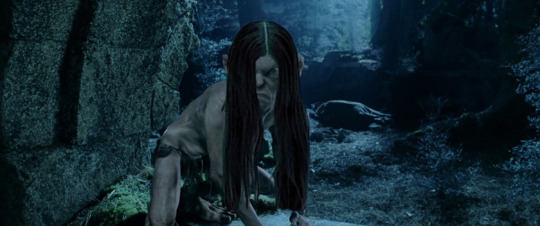
“So we’re not watching Ratatouille Peter O’Toole so much as Man of La Mancha Peter O’Toole. Imagine my delight.”
Actually, like the Marie/Clara name switch before, I have to wonder if this odd characteristic of Pantaloon is another subtle in-joke or reference towards the original story. Hoffman was a big Shakespeare fan and often referenced him in his writings, including The Nutcracker. In the book when Fritz’s soldiers desert the battle, the Nutcracker cries out the famous line from Richard the Third, “My kingdom for a horse!” (paired down here to a simple “Come back!” when the toy horses run free). In a weird way, having Pantaloon riff on Shakespeare is a nod to Hoffman. On top of that, one of his first lines is “All for one and one for all”, which everyone remembers from Alexandre Dumas’ The Three Musketeers. Years after Hoffman’s Nutcracker was published, Dumas wrote his own version of the story which is the lighter, softer one that the ballet takes the most cues from. So whether or not this was intentional is up for debate, but if it was I give the writers all the credit in the world for honoring both authors of The Nutcracker in such an obscure and subtle way.
The battle between the mice and the dolls promises to be an exciting one. The problem is once it gets going, it’s so wildly unfocused. The mice and dolls run around each other aimlessly firing and flailing at will. Clara could end all this just by kicking the mice to the other side of the room, but she just stands to the side and giggles at everything happening. Then there’s Marie, who in spite of Trudy strongarming her into helping the fight barely does anything other than scream in a stereotypical Southern accent and complain about how all this fighting is spoiling her complexion, like if she were a more spoiled version of Princess and the Frog’s Charlotte LaBouff. She’s marginally more tolerable that Pirlipat. Granted she does have one funny moment where her dress gets splattered with cheese and that’s what pushes her into a violent rage against the mice.
“And you will know my name is the Lord & Taylor when I lay my vengeance upon thee!”
Anyway, the mice hold down Nutcracker long enough for the Mouse King to have a go at killing him. Clara finally intervenes, throwing her slipper at the Mouse King and knocking him off his high toy horse. But she slips on a marble into the clock and falls unconscious.
Clara wakes up back in her bed on Christmas morning, her head wrapped up in bandages. Nobody believes what she saw the previous night, owing her delusions to a fever sustained from her injury. Drosselmeier pays Clara a surprise visit and presents her with a newly fixed Nutcracker. Grateful as she is, Clara calls him out for not doing anything when his own nephew was in danger, though Drosselmeier states he’s not the one who has the power to save him. Clara’s mother insists she stay in bed and do nothing for the rest of the day, which, come on Mom. Worst Christmas ever.
That evening the Mouse King also pops into Clara’s room to return her slipper. Awfully decent of him, all things considering. After making more big talk about how he’s gonna turn Nutcracker into a pile of splinters, Clara lures him into her drawer with the promise of some chocolates Fritz left her earlier and traps him in there. She flees downstairs to hide Nutcracker, but the Mouse King has mastered offscreen teleportation and threatens to kill Pavlova if she doesn’t hand him over. The owl on top of the clock changes into Drosselmeier and once again he brings the toys to life. This time it’s just for moral support as Nutcracker and the Mouse King battle mano-e-mouso up the Christmas tree. It’s a big improvement over the first battle. There’s more focus since it’s just the two of them fighting and there’s creative use of the terrain and presents around it. My one complaint is that Nutcracker doesn’t drunkenly tackle the tree itself at one point, but we can’t have everything we want for Christmas.
Whomsoever pulls the sword from the spruce shall become king of all Toyland! Oops, wrong mythos.
At one point the Mouse King nearly runs through a defenseless Nutcracker but Pantaloon bravely intervenes at the cost of a nasty back wound. Finally, Nutcracker delivers the killing blow and the Mouse King’s body crashes to the floor. The mice scatter and the toys declare victory. But Pantaloon’s batteries are about to expire, and since the Stahlbaums out of double-A’s the only way to save him is to get him to the Land of the Dolls; the gate to which is coincidentally right through Drosselmeier’s castle. Nutcracker eagerly invites Clara to join them, and after saying some mysterious something or other about time, Drosselmeier shrinks her down to their size with magic. They enter the castle, and Pavlova goes to inspect the Mouse King, which, for a decomposing corpse, seems to be growling an awful lot…
In the castle Marie gets sidetracked by the waltzing gentlemen while the rest continue on. They reach some lovely winter gardens where the snow is made of coconut icing and the royal swans Clara has fantasized earlier wait to take them on their journey. Since Marie is too late to join them, she has to settle for being dragged through the air on a common mallard.
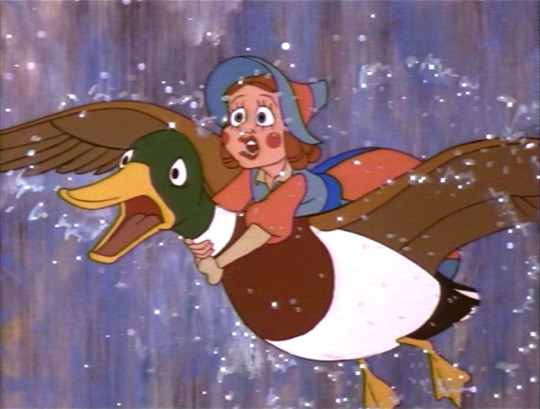
Still better than flying United Airlines.
The swans soar over a forest of Christmas trees up to the stars and through a magical waterfall that changes Clara and Nutcracker into attire befitting royalty and restores Pantaloon to health. They all land at a beautiful palace made of sweets where Nutcracker’s subjects give them a warm welcome. Clara and Nutcracker head out on to the ballroom floor to dance to my favorite piece from the ballet – scratch that, of any classical composer ��� the achingly beautiful Pas De Deux.
youtube
Like Clara’s solo before, the choreography is rotoscoped, but they’re much more clever at hiding it this time around. The dancing plays out like a dreamy montage with the moves fading in and out from one another, alternating between pink and blue silhouettes, minimally colored full-body shots, and more detailed animation reserved for closeups. There’s also an old-fashioned Vaseline-on-the-lens-style filter on, the kind normally reserved for romantic moments from Hollywood’s golden age which befits the tone they’re going for.
With the dance done, Nutcracker asks Clara to stay with him and rule the Land of the Dolls forever. Clara is sorely tempted, but something holds her back from saying yes. The idea of living in a candy castle with her dream prince and childhood friends is too good to be true, a perfect happy ending. And that’s just it – an ending. Clara has dreams beyond that will never come true if she settles, dreams of seeing the world and being a prima ballerina which can only happen if she chooses to grow up, and she wants to in spite of how much she’s fallen in love with Nutcracker. It would have hit harder if this theme of choosing to mature vs. clinging to girlhood was explored more throughout the movie, but the point still stands.
Now that the desire to grow up has taken hold, Pantaloon, Marie and Trudy change back into ordinary toys, the spark of life bestowed by childhood imagination put out. One by one, the denizens of the doll kingdom drop like flies, their number growing as Clara keeps justifying her refusal to stay.
And as if things couldn’t get any worse, guess who crashes the party?
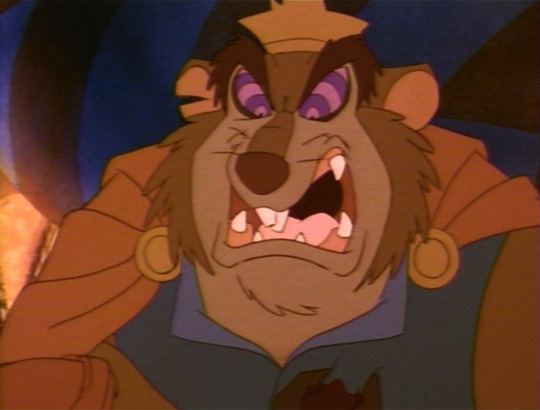
Ohhhhhh shiiiiit….
Up to this point the Mouse King was a comical villain who was difficult to take seriously. But now here he is like Ratigan in the final act of The Great Mouse Detective, bereft of his senses and embracing his inner animal. His chest wound is still bleeding, his breathing is ragged, he doesn’t even talk, and he shuffles forward like a zombie, but nothing holds him back his single-minded pursuit of Clara. You can’t even tell if he’s going after her because he recognizes the part she played in his eventual demise or he’s desperate to stick it to Nutcracker before he drops dead. Hell, maybe in his near-death state he’s so delusional that he thinks Clara IS Nutcracker. That makes it even more terrifying; he knows he’s dying but refuses to go without taking someone, anyone out with him in as violent a manner as possible.
The circle-eyes kind of kill it for me, though. I mean, when a bad guy or monster is cornering you in their final moments, which gaze is more threatening – bloodshot, glowing and blank, or colorful cartoon rings? Unless their name is Judge Doom, the answer should always be the former.
Defenseless, all Clara can do is pelt dessert at him. But it’s only delaying the inevitable. And when Nutcracker tries to help, the change slowly and painfully takes over him and he is forced to watch as his mortal enemy corners his true love, resulting in the most arresting visual of the movie.
Nutcracker gasps out Clara’s name one last time and morphs fully back into wood. A single tear remains on his face, the only sign he was ever truly alive.
The Mouse King traps Clara on the balcony, lunges at her and goes over the railing, finally taking himself out with a classic Disney villain fall. Clara pulls herself back up and sees the palace is now completely abandoned and filling up with mist. She cries desperately for her Nutcracker as the final heartrending strings of the Pas De Deux play, and the scene to slowly fades to black.
This scene…this whole scene from the moment the Pas De Deux began…how it got me when I was a kid. It broke my heart and did an echappé all over the pieces. Everything from the visuals to the acting and especially the music still punches me in the feels. For all my gripes about the inconsistent animation, this is the part of the movie where it absolutely shines. And thanks to the ramped up tension that follows every note, I’ve always associated this piece of Tchaikovsky’s score with poignant dramatic moments. Say what you will about the past hour of this movie, it is worth it for this excellent emotional climax.
Fritz bursts into Clara’s room startling her awake and declares Pavlova killed a crooked-tailed mouse by the clockwork castle. Clara dashes downstairs to the toy cabinet but finds Nutcracker is gone. She sprints out of the house straight to Drosselmeier’s shop. Oddly enough, he seems to be expecting her. Clara begs Drosselmeier to tell her if the story about the Nutcracker and the Mouse King is true for the sake of her sanity. But then, a handsome young man enters from the other room.
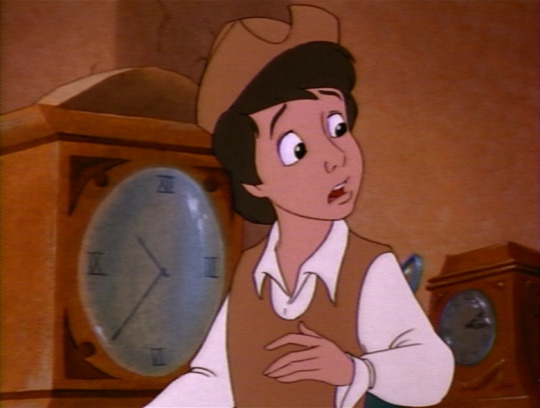
Drosselmeier introduces him as his nephew, Hans. Despite this apparently being their first time meeting, Hans greets her with familiarity, even bowing to her just as her Nutcracker Prince did. And his voice is one Clara would know anywhere. She in turn gives the perfect response.
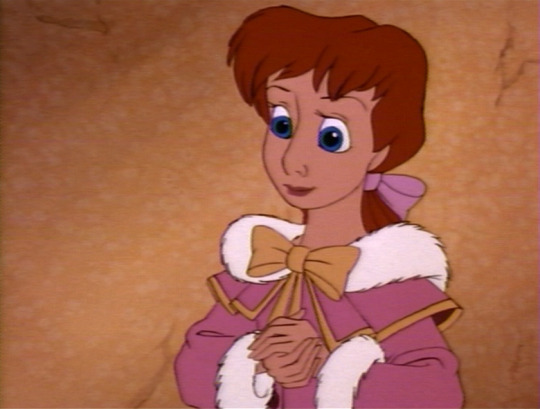
“Hello…Nutcracker.”
If the climax already left me nearly speechless than the finale takes whatever little words are left straight from my mouth. As far as endings go it’s near flawless. I’d say The Nutcracker Prince borrowed from Disney’s Beauty and the Beast if it weren’t for the fact that it came out the year before Beauty did. Like The Wizard of Oz, it knows how to leave you on an emotional high note. While it’s supposed to be ambiguous, it’s the kind where deep down you just know the real answer without any explanations given.

“Though I can only imagine how awkward it would have been after she said that if it did turn out to be a dream.”
“SHUT THE FUCK UP CYNICISM YOU WILL NOT RUIN THIS MOMENT FOR ME!!”
And because this was the 90’s, our end credits play over another Oscar-bait power ballad, this one being loosely inspired by the Waltz of the Flowers. Not one of the best, but still a good one to close the film on. Enjoy!
youtube
I honestly feel a little bad critiquing The Nutcracker Prince because at the end of the day it’s a fantasy, and fantasies play by their own emotional nonsensical surrealistic rules. It’d be like if Cinema Sins tried to blast a Jean Cocteau flick (and knowing those bastards’ egos they will if they haven’t already). Sure the characters aren’t the most deep, there’s some fluff in the story that could have been put to better use and the animation is inconsistent (characters go wildly off-model and if you pause at the right moment you’ve got plenty of fodder for the “DIDNEY WORL” meme) but when they get it right it’s wonderful. I’d say this and the obscure stop-motion version done by Sanrio (yes, the Hello Kitty factory) make for the most faithful and interesting retellings of The Nutcracker out there. I credit The Nutcracker Prince along with the Nutcracker Suite segment of Fantasia for introducing me to this magical music and story in the first place. I watched the tape quite a bit up until it got lost in the home entertainment shuffle, and enjoyed seeing it several times on the Disney Channel and Toon Disney during the holidays (and the occasional Christmas in July marathon). It’s not perfect, but hey, it wouldn’t be the holidays if you didn’t enjoy at least one imperfectly animated special that hits you over the head with nostalgia feels. Some people have Rankin-Bass, I have The Nutcracker Prince. And I hope the next generation will embrace it too.
Merry Christmas, and thank you for reading! Do you have a favorite version of The Nutcracker? Let me know in the comments! If you’d like to support me and see more reviews, consider supporting me on Patreon.
I’ll see you in the new year with Abby Kane’s requested review of Disney’s Pinocchio – that is, if my special Christmas present doesn’t keep me from finishing it on time (you’re going down, Ridley!!)
Artwork by Charles Moss.
Christmas Shelf Reviews: The Nutcracker Prince (1990) Merry Christmas everyone! To conclude this month of merrymaking we're looking at an animated Christmas cult classic that I have a bit of a soft spot for.
#1990&039;s#90&039;s#action#Action-Adventure#adventure#Alexandre Dumas#Always Come Back to You#animated#animated feature#animated movie#animated movie review#animation#Anne of Green Gables#ballet#battle#Canada#Canadian animation#Canadian movie#cartoon review#Christmas#Christmas movie#Christmas review#Clara#Clara and Hans#Clara Stahlbaum#cult classic#Dr. Stahlbaum#Drosselmeier#Drosselmeyer#ETA Hoffman
6 notes
·
View notes
Text
Fx deadly art of illusion

Fx deadly art of illusion movie#
Fx deadly art of illusion android#
Naturally, Bluey is used in fight scenes, and Bluey looks astonishinglyĭumb. And where F/X delivered some fairly effective illusions, FX2's biggest effect is a life-sized, articulated clown named Bluey, who mimics the actions of anyone wearing a special operator's suit.
Fx deadly art of illusion android#
But while F/X opened with an all too believable scene-a mob rubout in a Chinese restaurant-FX2 opens with a killer android in drag on the rampage
Fx deadly art of illusion movie#
Like the first film, FX2 opens on a reality/illusion joke: we see something violent, then the camera pulls back to reveal that we're on a movie set. FX2 really suffers from being a sequel there's no novelty to Rollie Tyler's act, and the act itself has worn thin. In addition, stars Bryan Brown and Brian Dennehy are enormously ingratiating actors their combined charm went a long way to keeping the whole business afloat. The first time, seldom work exactly the way they're supposed to, and are totally dependent on angles and lighting-but the picture moved quickly enough to keep viewers' minds off its implausibility. True, the stupendous dependability of his tricks flew in the face of what anyone who's ever worked with effects knows-that they never work But they persist, discover the location of the medallions, and use Rollie's arsenal of special effects to confront the bad guys and come out of it alive.į/X was a harmless, undemanding thriller, and the gimmick of a special effects artist using the illusions of his trade to escape real-life danger was novel. The police to the Mafia determined to teach them to mind their own business. Rollie and Leo find themselves on the hot seat, with everyone from They realize Mike was on the verge of solving the case, and that his death was part of a conspiracy to keep it in the closed file drawer. Together they uncover an unsolved crime, the theft of ten invaluable religious medallions. Though retired, Leo can still get the inside scoop on departmental matters. Rollie calls in Leo McCarthy (Brian Dennehy), his old buddy on the police force. Replaying the tape he made of the event, Rollieīecomes suspicious: the whole thing looks like a set-up, expressly designed to get Mike killed. Rollie agrees reluctantly, after being assured there's no way anyone can get hurt. Mike asks Rollie to help him set up a sting operation, designed to catch a peeping tom who's been threatening a model. It all seems too good to be true, and it is. Even her ex-husband Mike (Tom Mason), a detective, comes around to Rollie's charm. Rollie has a new girlfriend, Kim Brandon (Rachel Ticotin), whose small son Chris (Dominic Zamprogna) thinks Rollie is a pretty cool guy. He'd rather design elaborate, high-tech toys to delight andĪmuse children. He's also retired from working with the police, since his last real-life effects adventure was too violent for him. Rollie Tyler (Bryan Brown), ace special effects designer, has retired from creating illusions of mayhem for the movies. The VCI: Cinema Club trailer from 1996 with clips of "Misery", "King of New York", "Hamburger Hill", "Young Guns", "City Slickers", "The Lawnmower Man" and "Hellraiser & Hellraiser 3".FX2 is like a party guest convinced he's a real card, regardless of all evidence to the contrary it's a movie that revels in its own cleverness without being clever enough by half. End of FX2: The Deadly Art of Illusion (1991).Start of FX2: The Deadly Art of Illusion (1991).Peter Boretski as Carl Becker, Medallion Thief.Josie de Guzman as Marisa Velez, Police Computer Expert.Dominic Zamprogna as Chris Brandon, Mike's Son.Joanna Gleason as Assistant DA Liz Kennedy.

0 notes
Photo
Sorry or not..
CHASING RAIBOWS

37 notes
·
View notes
Text

Former Mayor Bill Stortz with Santa
As the year draws to a close and the news cycle continues to reset every day, let’s pause and look at some of images of Bristol from 2017.
Shamrock Road Race
471 North Main Street
Superintendent of Schools Ellen Solek
99 Main St. Bristol, CT 06010
Lynn M. Buthe
Central CT Chambers of Commerce
Photo (c) Imagekind
Professional Young Visionaries of Tomorrow
File photo
Photo (c) Historic Buildings of Connecticut
Former Bristol Mayor Bill Stortz talks with parents of Bristol Eastern High School
Submitted
New England Carousel Museum
Bristol City Hall
Mayor Ken Cockayne with Ben Carson
Submitted
Bristol Eastern High School Band and Choir
Bristol Republican Party headquarters at 425 North Main Street
Rt. 6 Farmington Ave. Eastbound
Jaymie Bianca
Santa Sunday, New England Carousel Museum
From left to right: Josh Medeiros, Vice President of the Memorial Boulevard Cultural Center, Chris Borucki, Project Sales Manager/Technician at Wesson Energy, Bristol Mayor Kenneth Cockayne, Raquel Kennedy, President of Victory Energy Solutions, and Violette Radomski of Eversource Energy.
Submitted
Photo (c) Bristol Economic Development
Veterans Strong Community Center Bristol CT.
Peter B. Kelley
2016 contest winners
Donna Ptak
Emily Bourassa (second from left) is shown with staff from the breast center including (from left): Clinical Coordinator and Breast Health Navigator Kathy Albano, RN, BSN, CN-BN, and Secretaries Jessica Rossomando and Cherie Granger.
Radio Shack Bristol located at Bristol Commons, 77 Farmington Avenue.
Anthony D’Amato
Brian’s Angels
Nutmeg State Financial Credit Union located in Walmart Market
Ken Cockayne
Eric Carlson
Connecticut House Republicans
Chelsea O’Donnell
Paint Nights Hosted by Freddy at the T-salon Cafe House. Art Instructors provided by The Studio.
File Photo
Harry C. Barnes Memorial Nature Center
Pictured from left to right: Captain Edward Spyros, Officer Michael Marino, Officer Andrew Boretsky and Mayor Kenneth Cockayne.
Bristol ARC Jerome Ave. Bristol CT.
Memorial Boulevard School
2014 Home and Business Expo
Photo (c) Bristol Fire Department
Representative student leaders from Guildford DAY and Guilford High School, from left Anthony Slate, Danielle Ott, Gabby Palumbo, and Eryk Derda, spoke against legalizing recreational marijuana at the StopPotCT press conference on March 7 at the State Capitol in Hartford.
“All Heart” Marketing Billboard. Photo (c) Bristol Development Authority
81 N Main St. Bristol
Latin Cravings 375 N Main St, Bristol, CT
David Mills City Council 3rd District Candidate. Dave Mills was a three-sport athlete at both Bristol High and Bristol Eastern High Schools, playing football, basketball and baseball. Photo (c) Bristol Sports Hall of Fame
Former Associated Market 15 Memorial Boulevard Bristol CT. 06010
Cumberland Farms Rt. 72 Bristol CT.
Eric Carlson candidate for City Council in the First District (R)
Bristol Police Complex
Photo (c) Bristol Police
Mecheal Hamilton
Bristol Boys & Girls Club
Main Street section of the former mall site Bristol Hospital purchased
The front view of Bristol Hospital’s proposed ambulatory center on the corner of Riverside Ave. Ext. and Main Street.
Former mall site
45th Annual Bristol Tramps Sports Reunion
Indian Rock Nature Preserve
Photo (c) Bristol Police
Walgreens isn’t saying which stores will close. Walgreens has 58 stores in Connecticut and Rite-Aid has 77 stores in the State.
Pictured from left to right: Joseph Vitale of Covanta. Lt. Richard Guerrera and Chief Brian Gould of the Bristol Police Department. Commissioner Elizabeth Phelan from the City of Bristol’s Water Commission. Kevin Rousseau and Mary Ruder of Covanta. Photo (c) Bristol Police Department
New Work ‘N Gear retail store in Bristol Plaza
Laura and Craig Minor helping out at For Goodness Sake Bristol
Josh Medeiros
A Look Inside: Imagine Nation Classroom
Julian Galindez 2016 Youth of the Year
Andrew Howe
Firefly Hollow Brewery 139 Center Street. Bristol, Connecticut
Rt. 6, at Farmington Ave and Stafford Ave. Bristol
Christina Baker Kline
Bristol GOP slate 2017
Photo (c) Historic Buildings of Connecticut
Photo (c) Ron Tessman 2017 Mum Festival Parade
ictured left to right: Connor Feeney Wallace, Trey Frechette, John Duncan, Jake Leone, Lead Advisor Officer George Franek, Ally McMahon, Justin Seamour, Isaiah Bernazal and Matt Faggaini.
Dr. Josh Medeiros City Council Candidate for District One (D)
Special Olympics Connecticut 2017
Bristol Senior Center
Bristol Police
Congressman John B. Larson
Brittany Barney and the Democratic slate for 2017
Bristol Police Department
New Cambridge Apartments
Walter Hushak of Southington
Photo (c) Blue Dragons 2016 Nutmeg State Games Weigh Lifting Competition
Richard Kriscenski
NNMA Domestic Violence Awareness Basketball Tournament 2017
The Wildcat wooden roller coaster at Lake Compounce
Coppermine Village
Bristol Police Department
St. Vincent DePaul Mission of Bristol, Inc.
Diane Waldron
Whit Betts
For Goodness Sake
Political yard sign in front of the former BCO on South Street
Photo (c) Historic Buildings of Connecticut
FOCUS Center for Autism in Canton
Photo (c) Bristol Police Department
Birge Pond Bristol CT.
72 Maple Street Bristol Connecticut
2 Divinity St, Bristol, CT.
Car Show
City Hall plague of current Mayor Ken Cockayne
Students at the Fresh Start School for adolescents affected by Autism sing the National Anthem at the June 21st ceremony held at the Canton Community Baptist Church honoring the first graduating class.
Palma’s Diner 100 Stafford Ave, Bristol, CT 06010 (860) 583-8131 palmasdinerct.com
Special Olympics Of Connecticut
Bristol Connecticut – Welcome to my House YouYube video
Richard Theriault Photo (c) Jayne Marra
NNMA Domestic Violence Awareness Basketball Tournament 2017
Southside School Bristol
99 Main St. Bristol, CT 06010
Bristol American Legion Post 2 Motorcycle Ride Raised Funds For Youth Week
Submitted
New England Carousel Museum
Photo (c) Heat For Heroes
1192 Burlington Avenue.
Fire Fly Brewing 139 Center Street Bristol, Connecticut 06010.
Detectives Robert Osborne, Ryan Kulig and Chief Brian Gould.
Former Marinellis Supper Club
A logo sign outside of the headquarters of ESPN in Bristol, Connecticut on November 21, 2015. Photo by Kristoffer Tripplaar *** Please Use Credit from Credit Field ***
457 Mason Jar 457 N Main St, Bristol, CT 06010
The honorary event co-chairs for the 2017 Bristol Hospital Ball are (from left): Margarita Reyes, MD, and Josephine Torno, MD.
Bristol Police Complex
Photo (c) Connecticut Lifestyles
Photo (c) Historic Buildings of Connecticut
St. Paul Catholic High School
Newly elect Mayor Ellen Zoppo-Sassu Photo (c) Calvin Brown
Cheryl Thibeault, Republican running for City Council in the Third District
99 Main St. Bristol, CT 06010
Walmart Bristol CT. Photo (c) Hive Mind
Jonmeshia White
Ellen Zoppo-Sassu
Student Robotics competition File photo
Jodi Zils Gagne Council member in the 2nd District.
Cortlandt Hull’s great aunt, actress Josephine Hull on the Warner Brothers set of “Arsenic & Old Lace” with Cary Grant, directed by Frank Capra.
Yearbook photo
2016 United Way’s “Day of Caring” at the Bristol Adult Resource Center BARC
Covanta Holdings Corp. owns trash-to-energy plant in Bristol
Fresh Worx
Photo (c) Seacoast Kids Calendar
The rear view of Bristol Hospital’s proposed ambulatory center on the corner of Riverside Ave. Ext. and Main Street.
Postcard displaying Main Street before redevelopment.
Mayor Ellen Zoppo-Sassu
Brian’s Angels
Chippanee Country Club
Doubletree Hotel Bristol CT.
Photos via ESPN Images
State Senator Henri Martin (R-31) and Representative William A. Petit, Jr. (R-22)
Pictured from left to right: Detective Michael Brasche, Explorers Kaitlyn Spann, Connor Fenney-Wallace and Officer Craig O’Connor.
Frankie’s of Bristol
Photo (c) Ron Tessman
New Firehouse Subs at Pier One Imports Plaza across the street from Bristol Plaza on Rt. 6.
he Church of the Eternal Light on Chippens Hill. Photo (c) Raymond Shaw
Barnes Nature Center
St. Philip House
Photo (c) Bristol Historical Society
Paul and Bond from Negative-G.com head to lake Compounce in Bristol Conneticut to experience the Boulder Dash Mountain Coaster. Photo (c) Paul B. Drabek
Bristol Roundup podcasting
61 East Main street Forestville CT. Photo (c)
United Way of West Central Connecticut
Federal Hill Green Bristol Connecticut
Danielle Benoit
Bristol CT. viral fight at Rockwell Park. Photo (c) New York Times
Courtesy photo submitted
Stakeholders gather to celebrate the installation of the emergency generator at the City of Bristol Pound. From L-R seated: Friends officers President Trish Ulin, Vice President Lindsey Rivers and Secretary Ellen Zoppo-Sassu. From L-R standing: Animal Control Officer Ray Zagorski, City of Bristol Facilities Director Dave Oakes, Animal Control Officer Brian Skinner, Alec Dill, O.J. Mann Electric Services, Bill Thomas, The Home Depot Store Manager in Bristol, Bryan Austin, City of Bristol custodial staff, and City Councilman David Preleski who serves on the Building Committee, along with Council members Dave Mills and Jodi Zils-Gagne who were unable to attend.
Former school on Chippens Hill
Kay Jewelers Rt. 6 Bristol CT.
New York Deli 257 Main St, Bristol, CT 06010
Photo (c) City of Bristol
David Preleski incumbent City Councilor for the Second District
2016 Award Recipients
Photos (c) Jordaan DiYulio & Cat Boyce
Mike Uchalid
Mark Halliday, Assisted Living Services/Assisted Living Technologies Community Liaison; veterans Bob Boucher and Roberto Gagliardi of Wallingford; Attorney Henry Weatherby, and veteran Bob Fortino of North Branford, at the Veteran’s Coffee House monthly gathering on August 29th at the Wallingford Senior Center.
Shown with the winning entry is (from left): Dr Sai Varanasi; Kathy Albano; Jayne Baczewski and Al Lamptey.
United Way of West Central CT
Bristol Soccer Club
Former New Departure Plant
Maria Brandriff
Todd Therrien
Mayor Cockayne
Photo (c) NPR
Simsbury Chamber of Commerce
Bristol Police Explorer Post 111, Chief Brian Gould and Mayor Ellen Zoppo- Sassu.
Photo (c) Bristol Police
Barnes Nature Center
Potential new leased City hall at 10 Main Street.
Bristol Police Department
Bristol Stomp bandstand early days
Professional Young Visionaries of Tomorrow
Miya Spinella (Left) Chelsea O’Donnell (right) Submitted photo
Mike Beattie
Photo (c) Carpenter Companies
Rep. Ben Ray Luján
Senator Henri Martin (R-31) touring South Park Inn
Shown from left to right are: President and CEO Kurt A. Barwis, FACHE; Professional Development Coordinators Valerie Varanelli, BSN, RN, and Kristin Waterman, MSN, RN; Nancy LaMonica, MSN, MHA, RN, PCCN, NEA-BC, director of clinical excellence, professional practice and Magnet; and Chris Ann Meaney, DNP, MHA, RN-BC, NE-BC, vice president of patient care services and chief nursing officer.
Bristol Fire Department
Pet Valu 594 Farmington Ave, Bristol, CT 06010
F. N. Manross Memorial Library
File photo
Walgreens isn’t saying which stores will close. Walgreens has 58 stores in Connecticut and Rite-Aid has 77 stores in state.
2015 Award Recipients
Pam Patterson Director of Marketing, For Goodness Sake, Inc.
Family Sunday Create-a-Cutout
New Cumberland Farms on Rt. 72 at Pine Street and Emmett Street Bristol
Bristol Police Department
Former Bristol Centre Mall site
New Town homes being built on Burlington Avenue
Photo (c) Bristol Police
465 North Main Street
Connecticut House Republicans
Pink’s Hot Dog located in Lake Compounce
St.Stanislaus Church in Bristol
Photo (c) FOCUS Center for Autism
Brian’s Angels Homeless Outreach
Morris “Rippy” Patton
Photo (c) NARAL Pro-Choice Connecticut PAC
Mark Thomas, Marketing and Public Relations Specialist
Ron Goralski
Heroin, Oxycodone and firearms found with
Forestville Center
Carousel Art Contest for Children
As the year draws to a close and the news cycle continues to reset every day, let's pause and look at some of images of Bristol from 2017. As the year draws to a close and the news cycle continues to reset every day, let's pause and look at some of images of Bristol from 2017.
4 notes
·
View notes
Text
"RACE TO FREEDOM: THE UNDERGROUND RAILROAD" (1994) Review

"RACE TO FREEDOM: THE UNDERGROUND RAILROAD" (1994) Review Many television viewers and moviegoers might be surprised to learn that Hollywood had aired a good number of television movies that featured the topic of U.S. slavery. One of those movies proved to be an offshoot of the 1977 miniseries, "ROOTS". However, another was the 1994 television movie called "RACE TO FREEDOM: THE UNDERGROUND RAILROAD".
The 1994 Canadian television movie is a story about the Underground Railroad, a loose network of secret routes and safe houses occasionally used by willing 19th-century slaves in the United States to escape to free states and Canada with occasional aid of abolitionists and allies sympathetic to their cause. Before one assumes this movie is about the history of the actual network . . . it is not. Instead, "RACE TO FREEDOM" told the story of four fugitive slaves from North Carolina, who made the journey north to freedom during the fall of 1850. Since their journey took place not long after the passage of the Compromise of 1850, the four fugitives were forced to journey to Canada, instead of a Northern state above the Mason-Dixon Line. The story began with two events - the capture of a slave named Joe, who is owned by a North Carolina planter named Colonel Fairling; and the arrival of a guest of Farley's, a Canadian ornithologist (studies birds) named Dr. Alexander Ross. Fairling is an amateur bird watcher who had invited Ross to observe the migration of certain bird in the area. Unbeknownst to the planter, Dr. Ross is also an abolitionist and newly-recruited member of the Underground Railroad. He has also arrived at the Fairling plantation to offer help to any slaves willing to escape. In the end, four slaves take up his offer - a blacksmith named Thomas; two field slaves named Minnie and Walter; and a house slave named Sarah, who is also Thomas' love and Joe's younger sister. After his men's failure to capture the four runaways, Fairling hires a professional slave catcher named Wort and his slave/tracker Solomon to find and capture them. Unlike some people, I believe that stories (in novels, movies, television, stage plays) about slavery (in any country) can be told in a variety of ways - as a family saga, a historical biopic, or even as a comedy satire on the sanctity of American history. "RACE TO FREEDOM" turned out to be an adventure tale in the form of a road trip, with history, action and romance for good measure. It is not the first movie about the Underground Railroad I have seen. But it is one of my two favorite productions on the topic. One of the reasons why "RACE TO FREEDOM" became such a favorite with me is that . . . well, screenwriters Peter Mohan and Nancy Trites-Botkin created a first-rate, solid screenplay. The pair did an excellent job of setting up the narrative with the two events mentioned - Joe's capture and Dr. Ross' arrival at the Farley plantation. The screenplay also allowed viewers to become acquainted with the movie's four protagonists, as they debate over whether or not to make the bid for freedom. It did the same for the two antagonists - the slave catching duo of Wort and Solomon. Mohan and Trites-Botkin's screenplay also did a solid job of presenting obstacles for the protagonists to overcome, as they made their way north from western North Carolina to Canada. And the screenplay also presented a northbound route that did not come off as implausible. I still shake my head in disbelief over the California-bound route that author George MacDonald Fraser plotted in one of his FLASHMAN novels. But more importantly, "RACE TO FREEDOM" proved to be a first-rate adventure filled with a well-written narrative, solid action, strong characterization, nail-biting suspense, a strong, if not perfect, grasp of history, and a surprising twist in the end. As I had earlier stated, "RACE TO FREEDOM" featured some strong characterizations. And this would not have been possible without a first-rate cast. The movie included some solid performances from Falconer Abraham, Jennifer Phipps, Peter Boretski and James Blendick. Dawnn Lewis gave a funny and sardonic performance as the pragmatic Minnie. Also, Tim Reid, Nigel Bennett and Alfre Woodward all made solid cameo appearances as abolitionists Frederick Douglass and Levi Coffin, and Underground Railroad conductor Harriet Tubman. However, in my opinion, the movie featured five performances that really impressed me. Both Janet Bailey and Courtney B. Vance gave superb and subtle performances as the two of the four slaves who attempt the journey for freedom. Not only was I impressed by how they conveyed the complex aspects of their respective personalities, I was also impressed by their strong, screen chemistry. Michael Riley gave a very interesting performance as the Canadian ornithologist, Dr. Alexander Ross, who heart seemed to be in the right place, despite his obvious lack of experience with the Underground Railroad. I especially enjoyed his interactions with Vance's character, Thomas. However, I feel that the two most interesting performances in the movie came from Glynn Turman and Ron White, who portrayed the two slave catchers, Solomon and Wort. The two actors did a superb job in conveying one of the most interesting and complex slave/master relationship I have ever seen on screen. Turman and White really made it easy for me to understand how emotionally complex that relationship can be. There is a lot to admire about "RACE TO FREEDOM". However, I did managed to spot certain aspects that I found questionable. The performances of the actors who portrayed Colonel Fairling's neighbors struck me as wooden and bad clichés of the typical Southern planter found in antebellum South movie and television productions of the last forty years. Two, actor Tim Reid was too old to be portraying abolitionist Frederick Douglass at the time. I guess I should not be surprised. "RACE TO FREEDOM" marked the third time this has happened. Reid was almost fifty when this movie was in production. And the abolitionist was 32 years old during the movie's setting of 1850. Finally, although I found Alfre Woodward's portrayal of Harriet Tubman rather entertaining, I found myself wondering why the historical figure was in this movie. Tubman usually operated as an Underground Railroad conductor between the Eastern Shore of Maryland and Canada - which meant she never went anywhere near Cinncinati, Ohio. Yet, this movie had her escorting runaways from Cinncinati. Worse, Trites-Botkin's screenplay strongly hinted that Tubman was a veteran conductor for the Underground Railroad. This is not true. Tubman had ran away from Maryland in December 1849. She did not begin her activities as a conductor until the late fall or early spring of 1850. During this movie's time setting, she was as much of a newbie as Dr. Ross. "RACE TO FREEDOM: THE UNDERGROUND RAILROAD" may not be easy to find. The television movie first aired on a cable network (unbeknownst to me) some twenty years ago. And I would have never found out about it, if it were not for the channel guide I had received from my cable company on a weekly basis. And thank goodness I managed to stumble across it. The production became one of my all time movies - television or otherwise - about U.S. slavery. If you can find it in a store, on Netflix or even on the Internet, I highly suggest that you watch it.
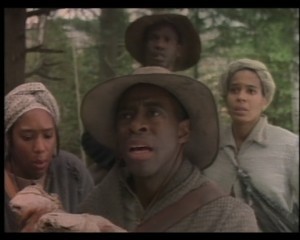
#race to freedom: the underground railroad#the underground railroad#slavery#u.s. history#courtney b. vance#janet bailey#dawnn lewis#falconer abraham#michael riley#ron white#glynn turman#alfre woodard#tim reid
1 note
·
View note
Text
Downloads The Nutcracker Prince online
The Nutcracker Prince movie download
Actors:
Megan Follows Peter Boretski Len Carlson Kiefer Sutherland Lynne Gorman Phyllis Diller Marvin Goldhar Mike MacDonald Peter O'Toole
Download The Nutcracker Prince
The film was directed by Paul Schibli and. Hoffman's classic book The Nutcracker and the Mouse King, this animated holiday tale. The Nutcracker Prince - Wikipedia, the free encyclopedia The Nutcracker Prince is a 1989 animated romantic fantasy film made by Lacewood Productions and released by Warner Bros. Pictures. The Nutcracker Prince - Rotten Tomatoes Review: Based on E.T.A. Starring Kiefer Sutherland, Megan Follows, Mike McDonald. When Clara. Hoffman's classic book The Nutcracker and the Mouse King, this animated holiday tale utilizes the vocal talents of such stars as Kiefer. The Nutcracker Prince | Moviefone - Movies | Movie Times | Tickets. the dance scene from The Nutcracker Prince of WB in 1990, I just love this movie the theme is "the prince and the sugar plum fairy" from Tschaikovsky's. The libretto is adapted from E. the nutcracker prince (the prince and the sugar plum fairy. The Nutcracker Prince: Information from Answers.com Plot Based on E.T.A. This animated version of the Christmas classic is more about combat than dancing, which will make it appealing to boys leery of a female protagonist. The film was directed by Paul Schibli and. . The Nutcracker Prince - Keyframe :: Find animation worth watching The Nutcracker Prince - Images, Reviews, Voice Actors, Crew Credits, Synopsis, Discussion, DVD The Nutcracker Prince - Christmas Specials Wiki The Nutcracker Prince is a 1990 animated film made by Lacewood Productions and released by Warner Bros. Based on E.T.A. An adaption of the classic tale of a girl's dreams turned reality when her new toy turns out to
Christie's Revenge hd movie Splinterheads online Scenes from a Teenage Killing
#The Nutcracker Prince#Megan Follows#Peter Boretski#Len Carlson#Kiefer Sutherland#Lynne Gorman#Phyllis Diller#Marvin Goldhar#Mike MacDonald#Peter O'Toole
1 note
·
View note